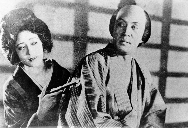
Running Time: 9 seconds
Compressed File Size: 1.2MB

OUTLINE
Daisuke Ito was born in 1898. He began working with film
as a scenario writer and made his debut as a director in 1924
with Tales of a Drunk. His 1927 film, Chuji's Voyages, earned
him wide critical acclaim. Okochi Denjiro, this film's lead,
first acted under Ito in 1926 and starred in most of the films
he made until 1935. For almost all the films that Ito made
during this ten year period, he used cinematographer Karasawa Hiromitsu. Unfortunately, Jirokichi the Rat is the only one of
the 20-odd silent films made by this famous trio that remains
in feature-length form.
The story was adapted by Ito from a novel written by Furukawa Eiji based on the life of Nezumi Kozo (The Rat), a notorious burglar active during the early 1800's (the end of the Edo Period). Nezumi Kozo won great fame for his daring adventures stealing from the homes of wealthy people late at night. Eventually he was captured and executed in 1835.
The film follows Jirokichi as he leaves Edo for Osaka to get away from the police. Along the way he meets Osen, a young woman forced into prostitution by her older brother. Although Osen falls for Jirokichi, his heart goes out to Okino, a poor girl from a fallen samurai family. Jirokichi learns that it was he himself who brought about the collapse of Okino's family when he robbed a rich feudal lord back in Edo. Nikichi, Osen's older brother, has got his own plans for Okino.
Osen and Okino are played by sisters Fushimi Naoe and Fushimi Nobuko respectively.
The film's pace is tightly controlled by a succession of scenes filled with action and close-ups. Since close-ups were technically impossible at the time, cinematographer Karasawa had to physically come in with the camera for these scenes. When he stops the camera close up on Okino's neck and hands, the scene takes on a subtly peaceful tone. There is an obvious contrast between such carefully controlled scenes with their calm mood and the chaotic fighting scenes filled with action and quick editing which gives the film a very tangible vitality.
The constant change of rhythm is also marked by the intertitles, in which the choice and flow of the words and the number of syllables set the entire story in a lyrical mode. The oratory force of Ito's silent films is yet further intensified by the narrative techniques of the benshi (film narrator). This, the expressions on the characters' faces and their moving lips make the film an art of oration that exceeds the "silent."

|
Download an excerpt of the movie in QuickTime format! Running Time: 9 seconds Compressed File Size: 1.2MB |
![[Matsuda company logo]](../images/matsuda_base.gif)